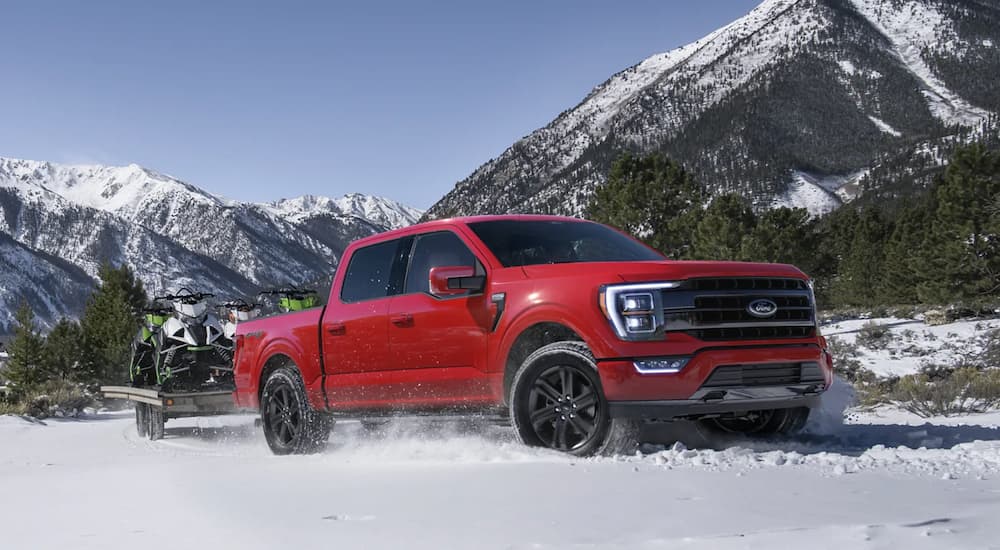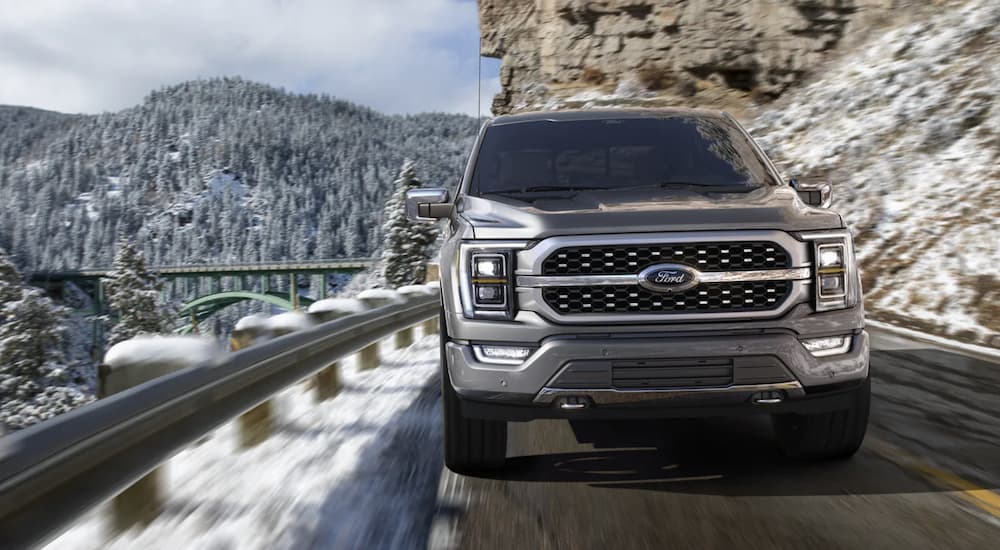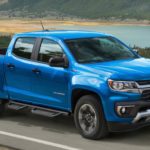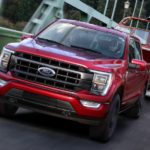Comparing the 2021 Ford F-150 vs 2021 Nissan Titan will reveal that they are both highly capable full-size pickups, but that is essentially where the similarities end. The Titan is designed to appeal to the middle of the road truck buyers, while the F-150 is more than capable of being customized from the factory to meet and exceed anyone’s needs and expectations. The Titan does come with a lot of standard equipment, but the F-150 can be had in that same specification or with far more features that the Titan doesn’t offer. The Titan appeals to the typical pickup buyer. The F-150 is the truck for everyone.
Powertrain Options (and Lack Thereof)
The most obvious difference between these two philosophies is found under the hood. The Titan offers a single power plant, the 5.6-liter Endurance V8. Making a respectable 400 horsepower and 413 pound-feet of torque, this engine is not that special but is more than adequate. While the Endurance lives up to its name when it comes to reliability, in terms of efficiency and power, it is lackluster. Nissan simply hasn’t allocated the funds to keep the old Endurance modernized, which is a stark contrast to the F-150’s various engines. The F-150 has a total of six powertrain options, ranging from the thundering 5.0-liter Coyote V8 and the torquey 3.0-liter Power Stroke turbo diesel to the highly advanced 3.5-liter PowerBoost Hybrid system.
The most budget-conscious option available for the F-150 is the solid 3.3-liter naturally aspirated V6. This engine still makes 290 horsepower, despite the low displacement and very low cost. The high specific power, that is, power per liter, is due to the engine being far more modern than the Nissan’s Endurance. Direct injection is included in the tough little 3.3-liter V6, as well as a lightweight all-aluminum design. Not only does the 3.3-liter allow the base F-150 to be sold for nearly ten thousand dollars less than the base Titan, but it also provides the right amount of power and torque to get the full-size pickup moving.
The EcoBoost series of turbocharged V6 engines have superseded the already roaringly stout Coyote V8 as the most powerful engines in the F-150 lineup. EcoBoost comes in three flavors in the F-150. This trio starts with a low-cost 2.7-liter that makes 400 pound-feet of torque at 3,000 RPM. That’s nearly as much as the 5.6-liter Nissan Endurance V8 but at less than half the displacement.
The most capable EcoBoost engines are the 3.5-liter twin-turbo variants. The standard 3.5-liter makes a staggering 400 horsepower and 500 pound-feet of torque, while the electrically boosted hybrid variant is the most powerful engine available on the F-150 at a shocking 430 horsepower and 570 pound-feet of torque.
In addition to this, the F-150 has the Coyote V8, which offers essentially the same power as the Endurance V8, but with greater efficiency and lower weight. Finally, the F-150 also offers a 3.0-liter diesel engine option, providing torque and fuel economy at low cost. In terms of engines, the Titan is both outnumbered and outgunned.
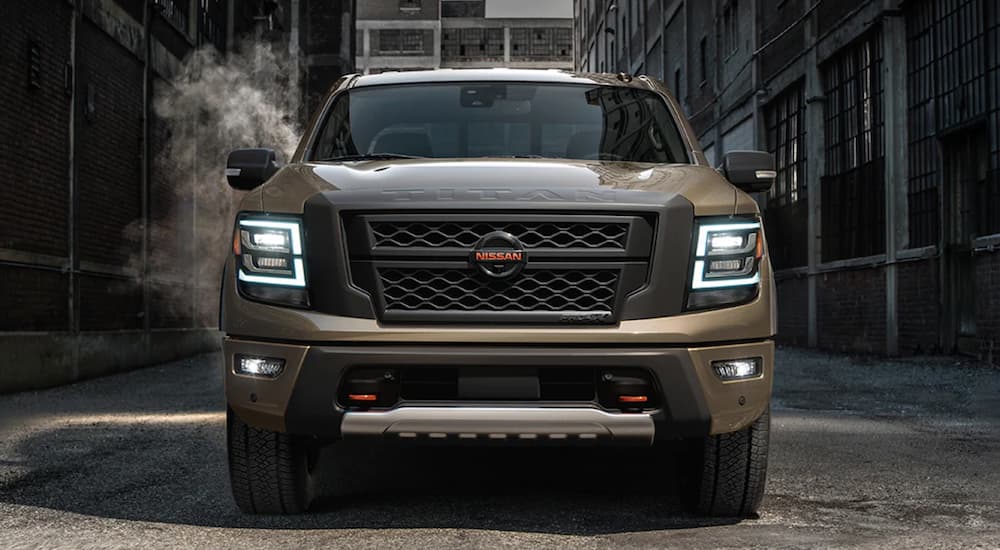
A Wealth of Technology
That theme of factory customization continues into the interior of the F-150, while the Titan once again tries its best to be a one size fits all truck. Both interiors offer a significant amount of space and comfort, though that can be said even of the F-150’s much cheaper base model.
Every F-150 comes standard with SYNC 4, Ford’s latest and greatest infotainment system. This includes a standard eight-inch color display in the center console, the same size as the standard infotainment display in the far more expensive Titan. The Titan’s infotainment system can be upgraded with a nine-inch display, but Ford easily surpasses that with the F-150’s available twelve-inch infotainment display. This huge screen makes operating the dozens of features and applications easier, even boasting a split-screen function so you can display two apps at the same time.
In terms of comfort, the Titan is not bad by any stretch of the imagination. Leather seats, a leather-wrapped steering wheel, and an 8-way power-adjustable driver’s seat are among the many features one can opt for in a Titan. But once again, the F-150 simply offers more. Heated first and second-row seats, a larger interior work surface, a twin-panel moonroof, and a Bang & Olufsen Unleashed Sound System are just a few of the available luxury features one can get on an F-150.
Additionally, the F-150 simply offers more cab and bed configurations, cementing it as the most adaptable and versatile truck in the industry. The Titan is far from bad, but it is badly outclassed by the segment leader.
Cutting Edge Design
Both the Titan and F-150 use the same time-honored body-on-frame design as their backbone, with the cab and bed structure placed on top of an extremely strong ladder frame. Peering deeper reveals a foundational difference between the two, though. The Titan is built primarily, almost purely, from steel. The frame, body, and bed are all overbuilt to a startling degree. While this does mean that the Titan certainly won’t suffer from frame or body buckling, it drives up the weight of the truck considerably, even compared to other steel-framed full-size pickup trucks.
The F-150, quite daringly, is made from high-strength aluminum. This makes the truck far lighter than steel-body trucks and a full thousand pounds or more lighter than the Titan. The F-150 managed to do this while actually improving strength simply by using more advanced materials and design tools. It is better to work smart than work hard, but the F-150’s frame and body do both.
This improved strength and massively reduced weight mean the F-150 is a much higher performance truck than the Titan overall, including acceleration, braking, payload, towing, cornering, and fuel economy. The full effect of that thousand-pound weight difference is hard to overstate.
The difference also means the F-150 is much easier on wear parts, including such important systems as the brakes. A thousand pounds less weight means the brake pads last longer, the rotors last longer, and less force is required to stop the vehicle. Weight not carried in frame and body material can be carried in payload and towing load instead, making for a far more athletic and capable truck overall. Even the tires’ job is made easier, as accelerating, turning, and stopping a truck that weighs a thousand pounds less is far less taxing.
It is Hard to Beat America’s Favorite Truck
The Titan is a capable vehicle and a serious truck, but the F-150 remains in a league of its own. At first glance, from the outside, they may appear similar, but the moment one looks under the hood or beneath the skin, it becomes readily apparent that the F-150 is an infinitely more versatile and adaptable vehicle.
The Titan has one rather old V8, while the F-150 has a litany of high-tech, high-capability engine options. The Titan has a cozy interior, but the F-150’s is designed both for maximum comfort and maximum productivity. And we haven’t even discussed the F-150’s unique features like its Pro Power Onboard built-in generator or its BlueCruise hands-free driving system. The Titan may be good, but the F-150 is the best.
